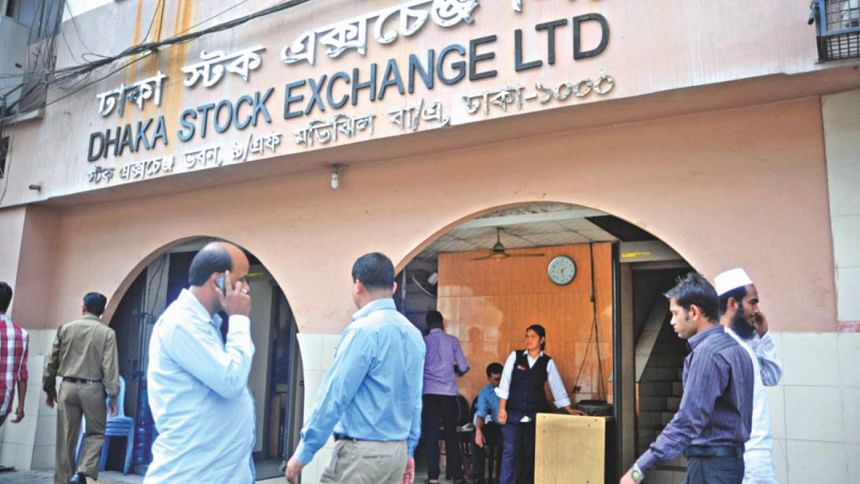A toxic sundae

Bangladesh's stock markets have been fluctuating sharply in recent years. The Dhaka Stock Exchange Index (DSEX), for instance, rose from slightly over 5,000 on January 1, 2017 to 6,240 on September 17 the same year, falling subsequently to 5,218 on December 17, 2018, before jumping to 5,950 on January 24, 2019 and then plummeting to 4,976 by end of September 2019. Market capitalisation declined nearly USD 6 billion by September end from its recent peak on February 7, 2019. The total number of Beneficiary Owner (BO) accounts dropped from 2.8 million in January 2019 to 2.56 million in September. Many loss-making investors exited the market, some squeezed their portfolios while others closed their accounts because of shrinking Initial Public Offerings (IPOs). According to media reports, seven companies raised Tk 4.95 billion through IPOs in January-September 2019, compared with eleven, mostly small, companies who raised Tk 5 billion during the same period last year.
Large volatility with periods of boom and bust has been a recurring feature of Bangladesh's stock markets. In 2010, following a steep rise, the DSE index fell by about a half from its December 2010 all-time high. The bear run wiped out USD 27 billion in market capitalisation, triggering a wave of social discontent. Given the interconnectedness between banks and equity markets, there was grave concern that a negative feedback loop could result from the stock market to the banking sector which could then spill over into the real economy.
Yes, not all the price fluctuations are market bubbles and bursts, but if these are not, what are?
Alan Greenspan, former chairman of the US Federal Reserve Board, coined the term "irrational exuberance" to describe investor enthusiasm that drives asset prices up to levels not supported by fundamentals. This gives rise to a bubble in asset prices. Investors engage in panic selling when the bubble bursts, sometimes selling their assets for less than they are worth. Bubbles are manifest when the market price of stocks exceeds their intrinsic value based on the fundamentals to a significant extent for an extended period.
The standard efficient market theory that rational investors always force stock prices to the objectively assessed present value of expected future cash flows has great difficulty explaining the frequent growth of bubbles and their subsequent bursts. Researchers in behavioural finance have devised alternatives to the standard model. They assume that investors are subject to a belief about future cash flows and investment risks that is not justified by the facts at hand. In other words, they are driven by unpredictable sentiments.
Kahneman and Tversky's "prospect theory" is most often quoted to explain the economic psychology of individual investors. They observe that "investors have an irrational tendency to be less willing to gamble with profits than with losses." People overweigh outcomes that are considered more certain than ones that are perceived just probable. Individuals tend to be risk-averse when things are going well. They are relatively prone to risk-taking when in dire straits. Thus, traders tend to pile on risks if they have already experienced losses and those experiencing profits tend to avoid further risk.
The "herding effect" also explains the dynamics of stock market bubbles and bursts. Herd behaviour is the tendency for individual investors to follow the actions, whether rational or irrational, of a larger group. People do what others are doing instead of using their own information or making independent decisions. Herding behaviour can increase because of fear, uncertainty or a shared identity of decision makers. Self-confident investors tend to rely more on private information for their investment decisions and, therefore, are less susceptible to herding. However, when the amount of investment is large, the investors are most likely to follow the actions of others to reduce their risks.
Changes in investor sentiments and herd behaviour can be ignited by market manipulation. The manipulators spread fake news encouraging common investors to buy in a bull run while the manipulators themselves sell when the market peaks. At this point, the common investors panic and unload their shares, leading to market crash. Information asymmetry explains how manipulators are able to mislead the retail investors who do not have the same information as the manipulators do about the valuation of stocks.
The combination of irrational exuberance, weak regulation and market manipulation can be highly toxic. A high-level probe in 2011 highlighted the limited enforcement of regulation by the Bangladesh Securities and Exchange Commission (BSEC). It identified trickeries performed by as many as five dozen influential individuals. The existence of omnibus accounts allowed them to make exorbitant profits at the expense of the retail investors. An analysis by the Asian Development Bank traced the proximate factors behind the boom and bust cycles to strained supervisory capacity and oversight by BSEC, lax and excessive reliance on margin lending requirements, unreliable financial reporting standards, lack of adjudication of securities cases and weak coordination across the regulators.
Liquidity injections do not work in these circumstances. The government sanctioned Tk 8.56 billion through the Investment Corporation of Bangladesh in May 2019 to boost investors' confidence. More recently, Bangladesh Bank decided to extend liquidity support to banks to stem the ongoing bear run. Bangladesh Bank will provide liquidity at 6 percent repo rate to banks having less than 25 percent of its capital exposed to stocks against government securities for as long as six months—a kind of quantitative easing. The banks can invest this money in stocks. Experience shows that such interventions at best have temporary effects if the information asymmetries are ubiquitous and regulatory environment is fundamentally weak.
High quality and timely information are the lifeblood of viable capital markets. The provision of high-quality information at a low cost through well-developed disclosure regimes gives investors the ability to assess securities. Repressive policies such as excessive requirements to hold government securities or paternalistic management of stock prices through IPO quotas hinder market development. Establishing viable legal environment ensures the efficient and fair enforcement of arm's length financial contracts and transactions. Independent regulators with well-defined objectives, funding and credible enforcement powers are better able to protect investors and ensure that capital markets are efficient and transparent.
Zahid Hussain is an economist.

 For all latest news, follow The Daily Star's Google News channel.
For all latest news, follow The Daily Star's Google News channel. 



Comments